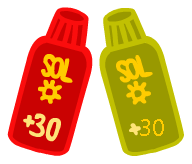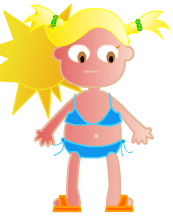 |
The Sun is life, and to enjoy it fully we must always use sun protection.
The Sun is a star that provides light for our planet Earth. This is a lot more important than we might think because not only does this light enable us to see things and give us a nice tan in the summer, but it also enables plants to thrive and produce the oxygen that all living beings need for breathing. But watch out, because too much of the sun’s rays can be damaging. In fact, we always think that having a nice tan is the same as being healthy, and that’s not true. |
How can I avoid getting sunburn?
 |
The best way to avoid sunburn is to sunbathe carefully. You have to realise that if you’re on the beach and sitting under an umbrella, the sun’s rays bounce back off the sand and reach your skin just the same. |
 |
So, the simplest way to protect yourself is to avoid the sun touching your skin directly, even on the rebound. With a hat or cap and proper clothes to cover you, you won’t have any problems. Even so, you still have to be wary, because young children’s skin is the most delicate when it comes to sunlight. |
 |
If you know you’ll be out in the sun you can use suncreams with a factor higher than 30 and which are water-resistant. Protective creams should be applied 30 minutes before sunbathing and reapplied every 2 or 3 hours. |
Oops I’m sunburnt! Now what should I do?
| If, even after taking notice of what you’ve been told, you’ve got a bit sunburnt, your skin will turn red, and you might even get blisters or start to peel. When you feel your skin starting to itch, the first thing to do is get out of direct sunlight. |  |
| Then you can apply a moisturising cream (which provides water for your skin because it will be very dry). If you don’t have any, you can apply cloths soaked in cold water over the burn site. |
|
Does the sun affect everyone the same?
We don’t all have the same skin colour. That’s because each of us has a different amount of the substance that gives us our colour (melanin).
Besides giving us our colour, this substance is also responsible for protecting us from the sun’s rays. So, people with more melanin will have darker skin and will be more resistant to the sun than those with less melanin who are paler.
And what about you, what type of skin do you have?
| Skintype | Reaction to sun |
| Very fair skin, blue eyes, freckles, fair hair | Your skin will go very red and start to peel. You won’t go brown very easily… |
| Fair skin, light-coloured eyes, fair or red hair | Your skin will go red and peel a bit. You’ll go a bit brown. |
| Pale skin, brown eyes and hair | Your skin will go a bit red and might even go quite brown. |
| Dark skin, dark eyes and hair | You’ll go brown very quickly and your skin probably won’t get irritated. |
| Black skin | The sun will make you even browner. |
In the snow and the sand, beware of the sun
|
|
At the beach and at the swimming-pool in summer, and up in the mountains in winter, you must be careful of the sun because sand and snow magnify its effects on the skin. This means that, especially in these places, you have to be even more wary. |
Some final advice
Here is a list of advice that you might find helpful when you want to sunbathe:
If you see a strange reaction on your skin, don’t hesitate to visit your doctor or pharmacist. |
Know what?


